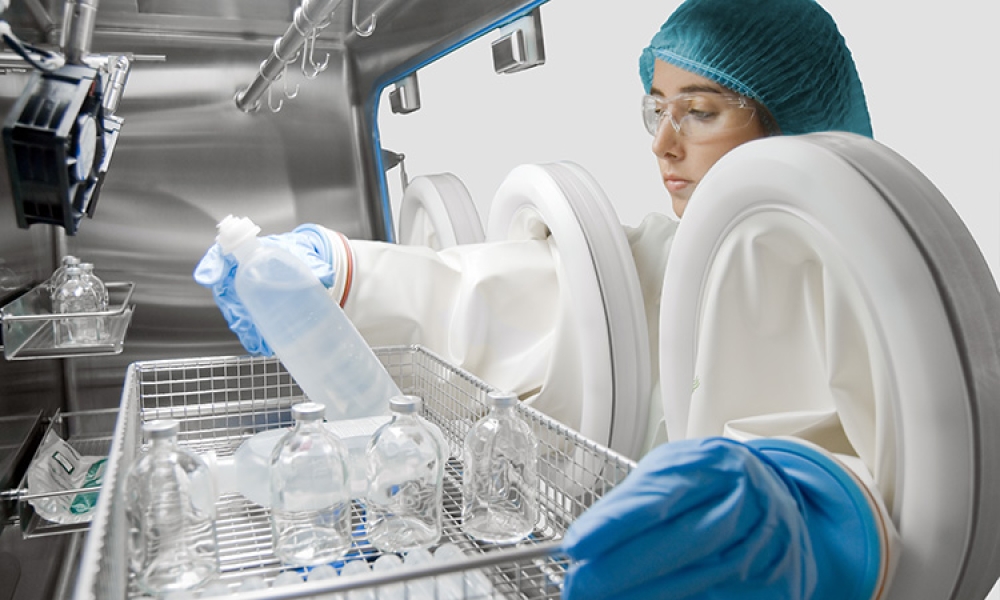The aim of this article is to help understand the main containment principles and to present the steps to be followed when establishing a containment strategy. It provides an overview of the ISPE’s Good Practice Guide “Containment for Potent Compounds”, published in December 2022. The guide is a success of knowledge consolidation to create a common understanding, a brilliant description of the...
Articles should explore the interactions of multidisciplinary functions and discuss the scientific application of experimental design methodologies as part of the product manufacturing process. Individual topics could include formulation, clinical phases, manufacturing, technology transfer, production scale-up, and optimization.
The intersection of AI and drug development has ushered in a transformative era, revolutionizing the way researchers approach biomarker/target identification, drug/target interactions, and drug-like molecule design. AI in the life sciences seeks to unravel intricate biological phenomena through systematic assimilation, analysis, and interpretation of expansive and diverse datasets.
To date, there has been a reluctance for cell therapy manufacturing facilities to move away from Grade B manufacturing suites even with the implementation of closed processing or the use of isolator technology. Read this article, “Cell Therapy and Closed Process Manufacturing” by Stephen Judd to learn about the potential to effectively operate cell therapy facilities in lower grade cleanroom...
The aim of this article is to help understand the main containment principles and to present the steps to be followed when establishing a containment strategy. It provides an overview of the ISPE’s Good Practice Guide “Containment for Potent Compounds”, published in December 2022. The guide is a success of knowledge consolidation to create a common understanding, a brilliant description of the...
The intersection of AI and drug development has ushered in a transformative era, revolutionizing the way researchers approach biomarker/target identification, drug/target interactions, and drug-like molecule design. AI in the life sciences seeks to unravel intricate biological phenomena through systematic assimilation, analysis, and interpretation of expansive and diverse datasets.
To date, there has been a reluctance for cell therapy manufacturing facilities to move away from Grade B manufacturing suites even with the implementation of closed processing or the use of isolator technology. Read this article, “Cell Therapy and Closed Process Manufacturing” by Stephen Judd to learn about the potential to effectively operate cell therapy facilities in lower grade cleanroom...
This article presents a comprehensive analysis of plastic waste generation in the biopharmaceutical industry, focusing on using single-use technologies (SUT) in bioprocessing for monoclonal antibody (mAb) production. It aims to inform sustainable practices within the biopharmaceutical industry and to encourage the development of more sustainable disposable technologies.
Single-use products used in the production of biologics provide flexibility that was unimaginable a few years ago. The implementation of single-use technology (SUT) in manufacturing operations has accelerated due to reduced risk, flexible process equipment adjustments, and lower capital cost. The widespread use of this technology has raised questions about its impact on the environment due to...
Drug delivery devices have become an essential component for many modern medical therapies, and it’s vital that they function as intended. However, the reality of marketed products shows that this is not always achieved because drug-device combination products are becoming increasingly complex, with an increasing number of potential failure modes. Significant challenges for engineers include...
Cell and gene therapy (C>) products address various diseases at the cellular or genetic level, offer innovative treatment approaches, and represent a significant advancement in the field of medicine. However, developers of C> products face unique challenges due to their complexity, such as establishing assays that show a clear link between potency, mechanism of action (MoA), and...
With the approval of the first gene edited therapeutic in 2023, production of gene edited therapies is accelerating, introducing tough decisions for manufacturing development. Gene editing therapy production is complex, often involving multi-modality manufacturing operations in one facility to produce a single therapeutic. This article considers whether retrofitting an aging monoclonal...
The ISPE Guide: Advanced Therapy Medicinal Products – Allogeneic Cell Therapy and the ISPE Guide: Advanced Therapy Medicinal Products – Recombinant AAV Comparability and Lifecyle Management were published earlier this year. These guides add to ISPE’s library of knowledge in the growing and ever-evolving advanced therapy medicinal products (ATMPs) field.
The US Food and Drug Administration (FDA) advocates for the integration of quality by design (QbD) principles throughout the pharmaceutical product development landscape, aiming to elevate both process understanding and product quality. Key challenges to the process control strategy include navigating time- and resource-intensive processes. One solution is digital shadow technology which, when...
Advanced therapy medicinal products (ATMPs) and cell and gene therapies (C>s) represent a promising medical product class that employs gene therapy, cell therapy, or tissue engineering to address various diseases and injuries. One critical aspect of ATMP and C> manufacturing is using cell culture media. With thousands of ATMPs and C>s in clinical trial phases, the role of...
Antibody engineering has transformed the development of therapeutic antibodies, enabling the creation of specific and effective treatments for a range of diseases. These antibody-based therapeutics are advancing in clinical development at a rapid rate and are being approved in record numbers. Currently, more than 100 monoclonal antibodies (mAbs) have been approved for the treatment of various...
Although traditional tank farm systems have long been the cornerstone of buffer preparation, they face challenges that have grown with the expansion of processing scale in the industry.
The validation of media and buffer mixing is a continuing area of resource constraint in the pharmaceutical industry. These validations require materials, validation associates’ time, and the use of equipment and processing areas. This article proposes a risk-based life cycle for minimizing mixing validation resource inputs, with the objective of optimizing validation efforts through the use...
Live biotherapeutic products (LBPs) have the potential to treat a wide range of ailments. However, these living microorganisms are difficult to produce due to evolving government regulations and limited GMP manufacturing experience. New facility designs and more specific process guidance could help overcome these challenges. This article explores the nuances of facility design and regulatory...
Cell and gene therapy (C>) products comprise a rapidly growing field of innovative medicines that hold the promise to treat and, in some cases, cure diseases that are otherwise untreatable. In this article, we provide points to consider when evaluating the comparability of C> when changes are made in their manufacturing processes.
There is much that large-scale commercial stem cell therapy processes can adopt from the existing bioprocessing industry. This article addresses some of the unique challenges posed by large-scale stem cell and stem cell–derived product manufacturing processes, and what should be considered while designing a manufacturing facility.
The field of advanced therapeutic medicinal products (ATMPs) has witnessed remarkable advancements in recent years. The Emerging Leaders (EL) community from the Belgium and Germany/Austria/Switzerland (D/A/CH) affiliates collaborated to develop an inclusive series of online seminars on ATMPs. This article gives highlights of the speakers, topics, and knowledge shared in ATMP online seminars...
In the interest of understanding the current state of continuous manufacturing for biologics and to facilitate the path toward adoption of these promising technologies, the United States Pharmacopeia (USP) and BioPhorum jointly sponsored a hybrid workshop. This article summarizes trends from the workshop and ponders next steps.
Continuous manufacturing (CM) challenged regulators’ expectations and regulatory frameworks. This article discusses how US regulators addressed the regulatory hurdles related to CM to broaden its adoption through engagement, regulatory science, guidance, and international harmonization.
While financial investment in novel therapies provides patients with new treatment options and improved quality of care, the pharmaceutical industry also recognizes its responsibility to transition toward more sustainable development, manufacturing, and stewardship of medicines throughout their life cycle.
Resounding clinical successes and maturation of extensive therapeutic pipelines have catapulted oligonucleotides from a fringe modality to therapeutic relevance in just a few short years. Oligonucleotides are a cornerstone of a burgeoning class of drugs classified as nucleic acid therapeutics. These therapies interact with DNA and RNA targets rather than traditional protein therapeutic...
In 2020, the world was grappling with how to slow the spread of the SARS-CoV-2 virus and appropriately treat people who had the COVID-19 infection without approved therapies or vaccines. In two years, there are multiple vaccines and treatments along with great knowledge about the virus—and about how the industry mobilized, partnered, and achieved tremendous strides in addressing the global...
Operation Warp Speed coordinated US government support of the pharmaceutical industry’s effort to develop and deliver vaccines and therapeutics across the United States to fight the COVID-19 pandemic. This article provides an inside look at the work done by this team to address the threat posed by COVID-19.
The implementation of a mammalian cell-based biopharmaceutical manufacturing process demands robust methods for knowledge handling, from early-stage development and technology transfer to production scale. Mathematical process modeling can summarize this knowledge as the relationships of critical quality attributes to critical process parameters using mathematical equations and sound...
Heightened awareness, due to the pandemic, of the need for domestic manufacturing capacity has rejuvenated the biopharmaceutical manufacturing industry and resulted in new commissioning projects. However, cross-country/continental travel restrictions and social distancing–based work protocols during the first two years of the pandemic necessitated adopting unique commissioning approaches....
With the publication of recent guidance, specifically the US FDA Quality Systems Approach to Pharmaceutical cGMP Regulations
With the rise of new technologies and predictive analytics capable of handling the huge amounts of data within and across existing information systems, Industry 4.0 has been thriving in many sectors, such as industrial automation, financial technology, retail, and semiconductors. But the health sector in general,
Historically, cell therapies are used to treat patients with cancer after relapse from other approved treatment modalities, or if no approved treatment is available. However, the introduction of allogeneic cell therapies has created exciting opportunities to broaden access to cell-based treatments. With advancements in manufacturing, developers are becoming increasingly interested in...
The process of bringing new drugs and products to market requires creativity, thinking outside the box, and the courage to fail numerous times before making a single discovery. This rings especially true now, as the industry faces the COVID-19 pandemic and doubts about vaccines and therapies getting to market in record time to improve human health. This article presents a deep dive into gene...
With so many options for personalizing our lives, is the personalization of medicine far behind? With all the data available, how can the industry bring personalized medicine to patients? This article explores what is currently available and where the pharmaceutical industry can move forward to better serve patient needs.
Viral inactivation (VI) is a critical step in ensuring the safety of monoclonal antibody (mAb), Fc fusion, and recombinant protein therapeutics and it is typically an important component of an overall virus control strategy for downstream biotherapeutic production processes. Considerations for successful implementation of an inline VI process are discussed in this article.
Continuous manufacturing (CM) offers one way the pharmaceutical industry can accelerate development of the drug product control strategy to ensure a robust and reliable supply of medicine to the clinic and/or market. This article explores the promise of continuous manufacturing in enhancing accelerated development, as evidenced by experience in solid oral products.
Cell and gene therapies are complex. As more therapies come to market in the hope of bringing advanced treatments and cures to rare, orphan, and difficult-to-treat diseases, designing quality standards for these personalized medicines is equally as complex.
Powder for oral suspension (PfOS) bioavailability is mostly on the basis of drug absorption from the gastrointestinal tract. PfOS formulation pH, viscosity, vehicle buffer capacity, drug particle size distribution, density, and viscosity are often critical for absorption. Therefore, careful design and selection of excipients—including suspending agents—are necessary during PfOS formulation...
Continuous manufacturing has attracted significant interest over the past decade for small molecules formulated as drug products. The case for adopting continuous manufacturing platforms for manufacturing biologics (i.e., large proteins or biologic products such as vaccines) would, in principle, be even more justified for both quality and business gains. This article briefly reviews continuous...
What if the reliability of a system could be improved by accessing the standard data provided with modern process instrumentation? These data, accessed from existing instrumentation, can be used to analyze the fitness of processes, equipment, and instruments; better understand processes; support discrepancy investigations; and provide a data-driven basis for the timing of maintenance and...
Digital transformation and digitalization are on the agenda for all organizations in the biopharmaceutical industry. But what are the main enablers of intelligent manufacturing? We hypothesize that data science–derived manufacturing process and product understanding is the main driver of digitalization in the bioprocessing industry for biologics manufacturing. In this article, the first of a...
Drug developers know that the odds of anyone compound demonstrating safety and efficacy for a disease and its affected populations are low. How can drug developers improve these odds and increase the efficiency and effectiveness of drug development? One useful tool is model-informed drug development (MIDD), which uses computer models to inform the design of clinical trials or to run...
Oligonucleotides are a relatively new class of drugs, composed of natural and synthetic nucleotides, which primarily include small interfering RNA (siRNA), micro RNA (miRNA), and antisense oligonucleotide (ASO). These molecules achieve therapeutic effects through RNA interference, degradation, or splice-modulating pathways.
The individual stories of patients—and their families—are welcome reminders to the pharmaceutical industry about just how meaningful pharmaceutical development, manufacturing, and delivery are every day to those patients and their families.
Vaccine development is an intricate undertaking, which may involve numerous challenges from the initial process of identifying an antigen to the final steps of delivering and administering the licensed product. The COVID-19 pandemic has put a spotlight on the science of vaccine development. As the world awaits a vaccine for the coronavirus, manufacturers face unprecedented pressure to respond...
The solubility behavior of drugs remains one of the most challenging aspects of formulation development and is a key determinant of a drug’s bioavailability. This article describes research aimed to improve solubility of a poorly water-soluble drug (ibuprofen) by preparing a porous solid dispersion using a flash evaporation technique.
Regulatory authorities have approved the use of recombinant monoclonal antibodies (mAbs) to treat infectious diseases
Medical treatments and pharmaceuticals are indispensable in improving quality of life. In recent years, however, pharmaceutical compounds have become a significant group of environmental pollutants, shown to pose risks to human health and have adverse environmental effects.

















































